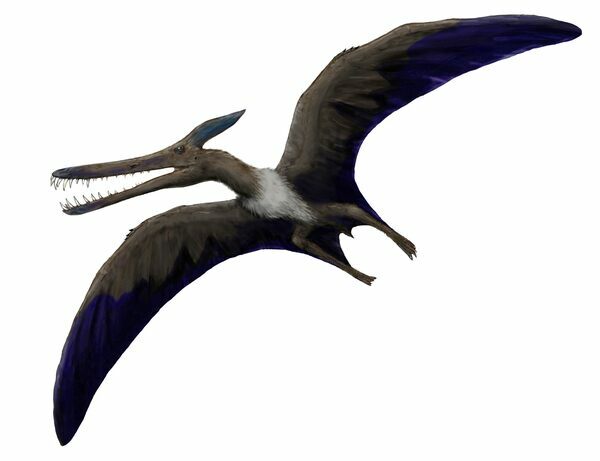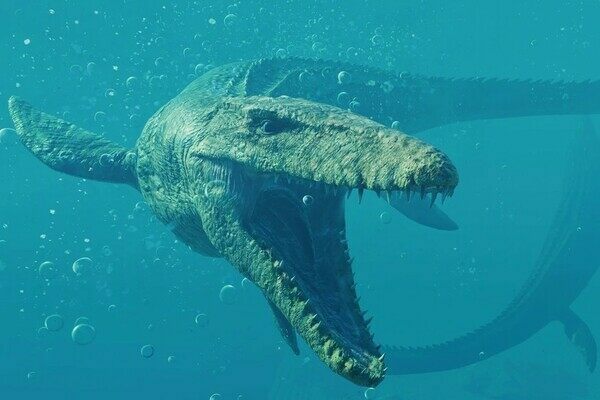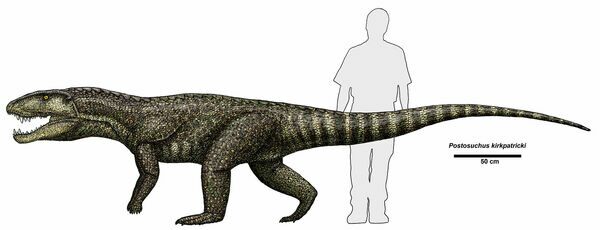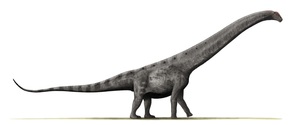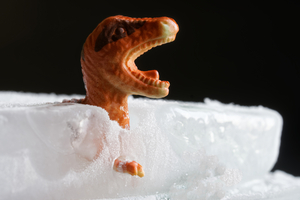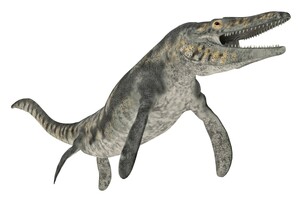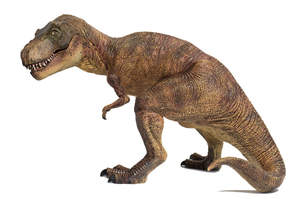The Dinosaurs That Never Were: Prehistoric Impostors
The paleontologically focused media revolves around dinosaurs, so it's not surprising that most news about fossils will go to great lengths to connect discoveries to the mesozoic era’s most famous residents, even tangentially.
Scientifically, what a dinosaur is defined as has changed over time, but generally can be explained as the most recent common ancestor of Triceratops horridus and modern birds, and all of its descendants. Triceratops and “Modern birds” can be substituted with any ornithischian and any saurischian dinosaur, respectively. This may be the rote, correct definition, but it’s certainly not the one that people will likely think of off the top of their head. For most, a dinosaur is simply a prehistoric monster, a symbol of the wild and untamed prehistoric past. However, by the time the first small dinosaurs took their shaky steps into the world they would come to dominate, millions of years of evolution and extinction had already taken place. In that time, a myriad of slimy, creepy, scaly and fuzzy creatures rose and fell, or lived alongside the dinosaurs, or even came after. Many of these creatures, because of superficial similarities or by virtue of simply being prehistoric, are lumped into the general public’s idea of what a “dinosaur” is. As a result, the cultural idea of what a dinosaur can be is a lot looser and less true than the true taxonomic definition.
From swimming mosasaurs, to flying pterosaurs, to the proto-mammal reptile-like synapsids of the pre-dinosaur era, and even to seemingly obvious non-dinosaurs like mammoths and megalodons, it seems that if it lived in the past, it’ll be mistaken for a dinosaur in the present. Here comes a list of some of the most commonly mistaken false dinosaurs, and where they actually lie on the tree of life.
The Triassic was a great diversification period for the reptiles, and in such a time of evolutionary experimentation, the Pterosaurs took to the skies and claimed the title of first vertebrates in flight. Only distantly related to the dinosaurs, both being part of the reptile clade “Ornithodira”, the similarities end right about there. Broadly called “pterodactyls” by the lay person, there actually is no creature with such a name designated by scientists. The closest would be the species Pterodactylus antiquus, a small pterosaur from the Jurassic period. Visually however, the most famous pterosaur is likely the much larger Cretaceous pterosaur genus Pteranodon. Pteranodon, known for its long toothless beak and striking, visually rudder-like head crest is most often used as *the* pop-culture pterosaur. Many pieces of media which use dinosaurs as setpieces will often use toothy-beaked, crested pterosaurs as their creature design, evoking both pteranodon as well as the earlier, toothed pterosaurs. It was thought by many scientists that this was just fiction conflating and exaggerating many different groups of pterosaurs together, as for the longest time, no pterosaur was ever found with both of those traits together. Until however, the discovery of Ludodactylus sibbicki. Ludodactylus, meaning “Toy finger” in reference to its resemblance to many cartoonish pterosaur toys, had both a pteranodon-like head crest as well as a beak full of pointy teeth, unlike all crested pterosaurs known at that point. While this certainly doesn’t mean that the makers of these toys were retroactively “correct”, it is important to keep an open mind when it comes to the past, as new discoveries can completely flip common perceptions on their heads.
In the oceans, reptiles ruled the Mesozoic just as much as they did the land and sky. However, they still weren’t dinosaurs. Many groups of reptiles rose and fell in the oceans of the Mesozoic, but just because they lived alongside the dinosaurs, does not mean that they *were* dinosaurs. The largest and most famous of these reptiles were the Ichthyosaurs, the Plesiosaurs, and the Mosasaurs. The Ichthyosaurs and Plesiosaurs have a less certain place in the reptile family tree, as it stands little is known about the origin of Ichthyosaurs, and they have been tentatively assigned to the Diapsid grouping. Plesiosaurs can be narrowed down a bit further, fitting into the Sauropterygia clade, though the position of Sauropterygia is disputed, with some placing it near the Ichthyosaurs, while others believe it to be part of the larger group Pantestudines, which would make their closest living relatives the turtles. The Mosasaurs however, have a much more certain placement, they are squamates, in the same family as snakes and lizards, and evolved from terrestrial lizards resembling monitors.
Ichthyosaurs were reptiles that resembled modern dolphins and other cetaceans, having long snouts with needle-like teeth for picking out fish and other small vertebrates. They were likely warm-blooded and viviparous, evidenced by fossils found with developed young inside the mother’s body. They may have also represented the largest non-mammalian vertebrate to ever live, with Shastasaurus sikanniensis reaching nearly 70 feet (23m) and about 75 tons, rivaling many modern cetaceans as well as many sauropod dinosaurs.
While not quite ever as large, the Plesiosaurs were arguably more successful, supplanting the ichthyosaurs for the reptilian kings of the sea during the Jurassic and much of the Cretaceous. The Plesiosaurs were further divided into the short-necked Pliosaurids and the long-necked Plesiosaurids, though there were exceptions to each category and the division is not as hard-drawn as it seems. Long necked Plesiosaurs used their relatively small heads to sneak up on schools of fish and not cast as much immediate suspicion on their prey of choice. Meanwhile, short-necked Pliosaurs had comparatively larger heads and bigger mouths, likely preying on larger prey, such as other plesiosaurs.
Lastly, the mosasaurs reached great lengths and became the closest thing to true “sea serpents” that have ever existed. These Squamate reptiles emerged in the mid-to-late Cretaceous period, and like the Plesiosaurs before them quickly became the dominant pelagic predators of the time. With huge heads and mouths, pharyngeal teeth and countershaded pigmentation, Mosasaurs likely lived like the slower modern sharks, ambushing prey with their countershaded camouflage and subduing them before they can even react to get away.
The dinosaurs emerged in the middle of the Triassic period of the Mesozoic era, about 230-240 million years ago, and became dominant in the wake of the Triassic-Jurassic extinction event. But dinosaurs were certainly not the only prehistoric reptiles, much less the only prehistoric animals to exist. In the desert of the pre-mesozoic Permian period, a certain large, famous synapsid acted as apex predator in a dry and hot world. Famous in appearance if not by name, Dimetrodon is perhaps the most distantly related animal on this list to the dinosaurs. As a member of the basal synapsid group called the pelycosaurs, Dimetrodon certainly casts a very reptilian-looking shadow. However, biologically, the resemblance is mainly superficial, with Dimetrodon’s ancestors splitting off from pre-reptilian amniotes at about the same time the true reptiles did. In point of fact, Dimetrodon’s lineage is more closely related to us humans than it is to any reptile, much less the dinosaurs. On top of that, the last Dimetrodon lived and died millions of years before the first dinosaurs had begun to evolve. Dimetrodon’s most famous feature was its huge sail-finned back, supported by tall, thin neural spines protruding from the tops of its vertebrae. These were possibly used as heat-exchange surfaces for life in the blisteringly hot deserts of the Permian. This was similar to the sail of the true dinosaur Spinosaurus, however Spinosaurus’s spines were laterally compressed, and it is thought that its sail was used for something other than heat exchange.
In the early Triassic period, dinosaurs had not yet arisen, their ancestors competing fiercely for the new niches that had opened in the wake of the Permian-Triassic extinction; the deadliest extinction event in the history of planet Earth. During this time, the ancestors of the dinosaurs found their strongest competition in their fellow archosaurs. These were the Pseudosuchians, mainly represented by terrestrial crocodile relatives that bore many superficial similarities to theropod dinosaurs, however the group also contains modern crocodilians. They were bipedal, and occupied many of the niches that would come to be occupied by dinosaurs after their extinction. The largest of these were the predatory Rauisuchians, and the largest of these was the massive Fasolasuchus tenax. Fasolasuchus lived late enough in the Triassic that it was a menace to some of the earliest dinosaurs as well, preying on them with its huge 30 foot (9m) body. While most of the Rauisuchids could walk bipedally, giving them a very dinosaur-like appearance, they had plantigrade feet, putting their whole foot on the ground when they walked, unlike dinosaurs, which had digitigrade feet, walking on only their toes. The pseudosuchians branched off of the larger Archosauria group very early on, and today are represented only by the crocodilians, which ironically often make people think of dinosaurs more than actual living dinosaurs (birds) do. To be fair to them, the pseudosuchians are the closest living relatives to dinosaurs that are not themselves dinosaurs, as both pseudosuchians and dinosaurs are both in the larger group Archosauria.
Some animals mistaken for dinosaurs are mistaken as such more rarely, but that makes it all the more baffling when they are. Take for example, the monster shark Megalodon, which lived and died millions of years after the last non-avian dinosaur choked in the dust of the K-T extinction. However, it also lived and died over 1 million years or so before the first hominid came out of the Rift Valley in Africa. Megalodon was, of course, a shark in the family Otodontidae, only distantly related to Dinosaurs in the sense that they were both chordates. It makes one wonder if some people’s only idea of a dinosaur is “an animal that has gone extinct and was scary”.
This applies also to some cenozoic megafauna as well. While certainly not often, it seems many forget the “saur” part of “Dinosaur”, and erroneously put animals like Wooly Mammoths and Saber-toothed cats in the category of “Dinosaur”, seemingly just because they were old animals that have since gone extinct. This is obviously not the case, as Dinosaurs are universally reptiles, and this excludes mammals.
Dinosauria was a vast and diverse clade of highly successful reptiles from the prehistoric past. They continue to live successfully today, in the form of birds, which are represented by over 10,000 living species. Dinosaurs were not, however, every animal that ever lived before the dawn of man, but instead only were one large order of many in the vast and varied tree of life.
Well, it is a little complex...
As stated previously, one of the best currently held definitions of what a dinosaur is systematically is the phylogenetic definition, that is to say a definition based on common relationships. This being “the most recent common ancestor of Triceratops horridus and modern birds, and all of its descendants”, which leaves little in the way of ambiguity. By using the last common ancestor of two rather disparate groups of dinosaurs, we can establish a temporal and physiological baseline for all animals that have descended from that common ancestor. Triceratops horridus and “modern birds” are used because they are both highly derived members of the ornithischian and saurischian dinosaur groups, respectively. Because they are related but separated from each other at the base of the dinosaur family tree, scientists can say with a large degree of certainty that their common ancestor would be close to or is the common ancestor of all dinosaurs, period.
However, that definition is not particularly descriptive to the layperson, and says nothing to the uninformed as to why one set of mounted bones in the museum is a dinosaur and one set of bones is not. This is where synapomorphies come in. In biology, synapomorphies are a set of traits shared by all members of a group, derived from its common ancestor. For an animal to be a dinosaur, it or a known ancestor must have every synapomorphy that defines the dinosaurs as a group. There are 12 major synapomorphies of the skeleton of dinosaurs that are confirmed, with a possibility of more. Most of these are small details of the skeletal structure, since this is the most well known structure of dinosaurs. The physical traits that define all dinosaurs are as follows:
In the skull, the supratemporal fenestrae, openings in the skull roof, have a supratemporal fossa, or groove, towards the front of the fenestrae. Fenestrae have many purposes, such as passage for nutrients or attachment sites for muscles.
Also in the skull, the exoccipital bones at the back of the head do not meet at the lower portion of the braincase. This may have allowed early dinosaurs to have larger brains than their competitors.
In the neck vertebrae, there are backwards pointing structures placed on the rear top corners, called epipophyses. These were not present on the first 2 vertebrae behind the skull, and were thought to be sites of muscular attachment.
The pelvis of dinosaurs is composed of three bones, the ischium, the ilium, and the pubis. Dinosaurs (and some related archosaurs) are unique for having what’s called a “perforate acetabulum”, or an open hip socket not filled with bone. Within the pelvis, part of the open hip joint extends between the contacts of the ischium with its neighboring bones, the ilium and the pubis.
The attachment point on the humerus (the upper arm bone) for chest and shoulder muscles, called a deltopectoral crest, is located at or beyond 30% the length of the humerus.
The radius of the forearm, one of the two bones that make up the forearm in most tetrapods (like us), is less than 80% the length of the humerus.
On the femur, located at the back and around the middle of the femoral shaft, is the fourth trochanter, a large asymmetrical muscle attachment site for the caudofemoralis muscle. This muscle attaches the thigh muscles to the tail, giving dinosaurs a strong stride.
The asymmetry of the fourth trochanter is also unique to dinosauria, broadening the extent to which the caudofemoralis muscle is attached to the femur.
In the tibia, or shinbone, there is a distinct crest, called a cnemial crest, on the top surface that curves frontward and outward.
At the bottom of the tibia, there is a ridge on the back, unique to dinosaurs.
In the feet, the uppermost connective surface for the fibula, one of the lower leg bones, is less than 30% of the width of the ankle bones.
Angielczyk, K. D. (2009). "Dimetrodon is Not a Dinosaur: Using Tree Thinking to Understand the Ancient Relatives of Mammals and their Evolution". Evolution: Education and Outreach. 2 (2): 257–271.
Nesbitt, S.J. (2011). "The early evolution of archosaurs: relationships and the origin of major clades". Bulletin of the American Museum of Natural History. 352: 1–292.
Bonaparte, J. F. (1986). Locomotion in Rauisuchid Thecodonts. Journal of Vertebrate Paleontology 3(4):210-218.
Bennett, S.C. (1994). "The Pterosaurs of the Niobrara Chalk". The Earth Scientist. 11 (1): 22–25.
Frey, E., Martill, D., and Buchy, M. (2003). A new crested ornithocheirid from the Lower Cretaceous of northeastern Brazil and the unusual death of an unusual pterosaur. In: Buffetaut, E., and Mazin, J.-M. (eds.). Evolution and Palaeobiology of Pterosaurs. Geological Society Special Publication 217:56–63.
Caldwell, M. W. (1996). "Ichthyosauria: A preliminary phylogenetic analysis of diapsid affinities". Neues Jahrbuch für Geologie und Paläontologie, Abhandlungen. 200 (3): 361–386.
Prehistoric Sea Monster Was Nearly the Size of a Blue Whale | Live Science
Benson, R. B. J.; Druckenmiller, P. S. (2013). "Faunal turnover of marine tetrapods during the Jurassic-Cretaceous transition". Biological Reviews. 89 (1): 1–23.
Grigoriev, D.W. (2014). "Giant Mosasaurus hoffmanni (Squamata, Mosasauridae) from the Late Cretaceous (Maastrichtian) of Penza, Russia". Proceedings of the Zoological Institute RAS. 318 (2): 148–167.
Shimada, Kenshu (2019). "The size of the megatooth shark, Otodus megalodon (Lamniformes: Otodontidae), revisited". Historical Biology. 33 (7): 1–8.
Scientifically, what a dinosaur is defined as has changed over time, but generally can be explained as the most recent common ancestor of Triceratops horridus and modern birds, and all of its descendants. Triceratops and “Modern birds” can be substituted with any ornithischian and any saurischian dinosaur, respectively. This may be the rote, correct definition, but it’s certainly not the one that people will likely think of off the top of their head. For most, a dinosaur is simply a prehistoric monster, a symbol of the wild and untamed prehistoric past. However, by the time the first small dinosaurs took their shaky steps into the world they would come to dominate, millions of years of evolution and extinction had already taken place. In that time, a myriad of slimy, creepy, scaly and fuzzy creatures rose and fell, or lived alongside the dinosaurs, or even came after. Many of these creatures, because of superficial similarities or by virtue of simply being prehistoric, are lumped into the general public’s idea of what a “dinosaur” is. As a result, the cultural idea of what a dinosaur can be is a lot looser and less true than the true taxonomic definition.
From swimming mosasaurs, to flying pterosaurs, to the proto-mammal reptile-like synapsids of the pre-dinosaur era, and even to seemingly obvious non-dinosaurs like mammoths and megalodons, it seems that if it lived in the past, it’ll be mistaken for a dinosaur in the present. Here comes a list of some of the most commonly mistaken false dinosaurs, and where they actually lie on the tree of life.
Pterosaurs
The Triassic was a great diversification period for the reptiles, and in such a time of evolutionary experimentation, the Pterosaurs took to the skies and claimed the title of first vertebrates in flight. Only distantly related to the dinosaurs, both being part of the reptile clade “Ornithodira”, the similarities end right about there. Broadly called “pterodactyls” by the lay person, there actually is no creature with such a name designated by scientists. The closest would be the species Pterodactylus antiquus, a small pterosaur from the Jurassic period. Visually however, the most famous pterosaur is likely the much larger Cretaceous pterosaur genus Pteranodon. Pteranodon, known for its long toothless beak and striking, visually rudder-like head crest is most often used as *the* pop-culture pterosaur. Many pieces of media which use dinosaurs as setpieces will often use toothy-beaked, crested pterosaurs as their creature design, evoking both pteranodon as well as the earlier, toothed pterosaurs. It was thought by many scientists that this was just fiction conflating and exaggerating many different groups of pterosaurs together, as for the longest time, no pterosaur was ever found with both of those traits together. Until however, the discovery of Ludodactylus sibbicki. Ludodactylus, meaning “Toy finger” in reference to its resemblance to many cartoonish pterosaur toys, had both a pteranodon-like head crest as well as a beak full of pointy teeth, unlike all crested pterosaurs known at that point. While this certainly doesn’t mean that the makers of these toys were retroactively “correct”, it is important to keep an open mind when it comes to the past, as new discoveries can completely flip common perceptions on their heads.
Marine Reptiles - Ichthyosaurs, Plesiosaurs, and Mosasaurs
In the oceans, reptiles ruled the Mesozoic just as much as they did the land and sky. However, they still weren’t dinosaurs. Many groups of reptiles rose and fell in the oceans of the Mesozoic, but just because they lived alongside the dinosaurs, does not mean that they *were* dinosaurs. The largest and most famous of these reptiles were the Ichthyosaurs, the Plesiosaurs, and the Mosasaurs. The Ichthyosaurs and Plesiosaurs have a less certain place in the reptile family tree, as it stands little is known about the origin of Ichthyosaurs, and they have been tentatively assigned to the Diapsid grouping. Plesiosaurs can be narrowed down a bit further, fitting into the Sauropterygia clade, though the position of Sauropterygia is disputed, with some placing it near the Ichthyosaurs, while others believe it to be part of the larger group Pantestudines, which would make their closest living relatives the turtles. The Mosasaurs however, have a much more certain placement, they are squamates, in the same family as snakes and lizards, and evolved from terrestrial lizards resembling monitors.
Ichthyosaurs were reptiles that resembled modern dolphins and other cetaceans, having long snouts with needle-like teeth for picking out fish and other small vertebrates. They were likely warm-blooded and viviparous, evidenced by fossils found with developed young inside the mother’s body. They may have also represented the largest non-mammalian vertebrate to ever live, with Shastasaurus sikanniensis reaching nearly 70 feet (23m) and about 75 tons, rivaling many modern cetaceans as well as many sauropod dinosaurs.
While not quite ever as large, the Plesiosaurs were arguably more successful, supplanting the ichthyosaurs for the reptilian kings of the sea during the Jurassic and much of the Cretaceous. The Plesiosaurs were further divided into the short-necked Pliosaurids and the long-necked Plesiosaurids, though there were exceptions to each category and the division is not as hard-drawn as it seems. Long necked Plesiosaurs used their relatively small heads to sneak up on schools of fish and not cast as much immediate suspicion on their prey of choice. Meanwhile, short-necked Pliosaurs had comparatively larger heads and bigger mouths, likely preying on larger prey, such as other plesiosaurs.
Lastly, the mosasaurs reached great lengths and became the closest thing to true “sea serpents” that have ever existed. These Squamate reptiles emerged in the mid-to-late Cretaceous period, and like the Plesiosaurs before them quickly became the dominant pelagic predators of the time. With huge heads and mouths, pharyngeal teeth and countershaded pigmentation, Mosasaurs likely lived like the slower modern sharks, ambushing prey with their countershaded camouflage and subduing them before they can even react to get away.
Dimetrodon
The dinosaurs emerged in the middle of the Triassic period of the Mesozoic era, about 230-240 million years ago, and became dominant in the wake of the Triassic-Jurassic extinction event. But dinosaurs were certainly not the only prehistoric reptiles, much less the only prehistoric animals to exist. In the desert of the pre-mesozoic Permian period, a certain large, famous synapsid acted as apex predator in a dry and hot world. Famous in appearance if not by name, Dimetrodon is perhaps the most distantly related animal on this list to the dinosaurs. As a member of the basal synapsid group called the pelycosaurs, Dimetrodon certainly casts a very reptilian-looking shadow. However, biologically, the resemblance is mainly superficial, with Dimetrodon’s ancestors splitting off from pre-reptilian amniotes at about the same time the true reptiles did. In point of fact, Dimetrodon’s lineage is more closely related to us humans than it is to any reptile, much less the dinosaurs. On top of that, the last Dimetrodon lived and died millions of years before the first dinosaurs had begun to evolve. Dimetrodon’s most famous feature was its huge sail-finned back, supported by tall, thin neural spines protruding from the tops of its vertebrae. These were possibly used as heat-exchange surfaces for life in the blisteringly hot deserts of the Permian. This was similar to the sail of the true dinosaur Spinosaurus, however Spinosaurus’s spines were laterally compressed, and it is thought that its sail was used for something other than heat exchange.
Pseudosuchians - Crocodile Relatives
In the early Triassic period, dinosaurs had not yet arisen, their ancestors competing fiercely for the new niches that had opened in the wake of the Permian-Triassic extinction; the deadliest extinction event in the history of planet Earth. During this time, the ancestors of the dinosaurs found their strongest competition in their fellow archosaurs. These were the Pseudosuchians, mainly represented by terrestrial crocodile relatives that bore many superficial similarities to theropod dinosaurs, however the group also contains modern crocodilians. They were bipedal, and occupied many of the niches that would come to be occupied by dinosaurs after their extinction. The largest of these were the predatory Rauisuchians, and the largest of these was the massive Fasolasuchus tenax. Fasolasuchus lived late enough in the Triassic that it was a menace to some of the earliest dinosaurs as well, preying on them with its huge 30 foot (9m) body. While most of the Rauisuchids could walk bipedally, giving them a very dinosaur-like appearance, they had plantigrade feet, putting their whole foot on the ground when they walked, unlike dinosaurs, which had digitigrade feet, walking on only their toes. The pseudosuchians branched off of the larger Archosauria group very early on, and today are represented only by the crocodilians, which ironically often make people think of dinosaurs more than actual living dinosaurs (birds) do. To be fair to them, the pseudosuchians are the closest living relatives to dinosaurs that are not themselves dinosaurs, as both pseudosuchians and dinosaurs are both in the larger group Archosauria.
Megalodon, Mammoths, and Sabre-Tooth Cats
Some animals mistaken for dinosaurs are mistaken as such more rarely, but that makes it all the more baffling when they are. Take for example, the monster shark Megalodon, which lived and died millions of years after the last non-avian dinosaur choked in the dust of the K-T extinction. However, it also lived and died over 1 million years or so before the first hominid came out of the Rift Valley in Africa. Megalodon was, of course, a shark in the family Otodontidae, only distantly related to Dinosaurs in the sense that they were both chordates. It makes one wonder if some people’s only idea of a dinosaur is “an animal that has gone extinct and was scary”.
This applies also to some cenozoic megafauna as well. While certainly not often, it seems many forget the “saur” part of “Dinosaur”, and erroneously put animals like Wooly Mammoths and Saber-toothed cats in the category of “Dinosaur”, seemingly just because they were old animals that have since gone extinct. This is obviously not the case, as Dinosaurs are universally reptiles, and this excludes mammals.
Dinosauria was a vast and diverse clade of highly successful reptiles from the prehistoric past. They continue to live successfully today, in the form of birds, which are represented by over 10,000 living species. Dinosaurs were not, however, every animal that ever lived before the dawn of man, but instead only were one large order of many in the vast and varied tree of life.
What Is A Dinosaur, Exactly?
Well, it is a little complex...
As stated previously, one of the best currently held definitions of what a dinosaur is systematically is the phylogenetic definition, that is to say a definition based on common relationships. This being “the most recent common ancestor of Triceratops horridus and modern birds, and all of its descendants”, which leaves little in the way of ambiguity. By using the last common ancestor of two rather disparate groups of dinosaurs, we can establish a temporal and physiological baseline for all animals that have descended from that common ancestor. Triceratops horridus and “modern birds” are used because they are both highly derived members of the ornithischian and saurischian dinosaur groups, respectively. Because they are related but separated from each other at the base of the dinosaur family tree, scientists can say with a large degree of certainty that their common ancestor would be close to or is the common ancestor of all dinosaurs, period.
However, that definition is not particularly descriptive to the layperson, and says nothing to the uninformed as to why one set of mounted bones in the museum is a dinosaur and one set of bones is not. This is where synapomorphies come in. In biology, synapomorphies are a set of traits shared by all members of a group, derived from its common ancestor. For an animal to be a dinosaur, it or a known ancestor must have every synapomorphy that defines the dinosaurs as a group. There are 12 major synapomorphies of the skeleton of dinosaurs that are confirmed, with a possibility of more. Most of these are small details of the skeletal structure, since this is the most well known structure of dinosaurs. The physical traits that define all dinosaurs are as follows:
Works Cited
Prehistoric Sea Monster Was Nearly the Size of a Blue Whale | Live Science
 Reviews
Reviews
